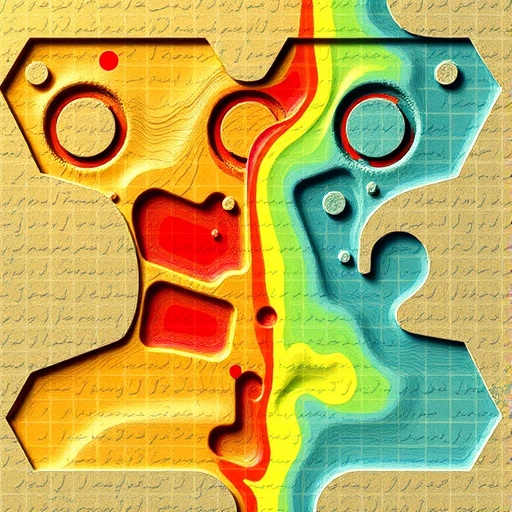In the evolving landscape of mining operations, the challenges of measuring and predicting blasting fragmentation are increasingly significant. A recent study introduces a groundbreaking approach that integrates fuzzy theory with multiple weighting methods to enhance the precision of fragmentation predictions. This comprehensive evaluation and prediction model aims to transform how mining professionals handle blasting operations, ultimately leading to improved efficiency and safety in extraction processes.
At the core of this research is the recognition that blasting fragmentation plays a critical role in mining effectiveness. The size and distribution of rock fragments directly impact productivity, equipment wear, and overall operational costs. Traditional methods of predicting fragmentation often lack the flexibility and adaptability needed to cope with the complexities found in real-world mining environments. The study conducted by Zhou, Yao, Monjezi, and their team addresses these limitations by leveraging fuzzy logic—a mathematical framework designed to handle uncertainties and imprecision.
Fuzzy theory is particularly suited for mining applications, where variables such as rock type, blast design, and geological conditions can fluctuate significantly. By using this theory, the researchers developed a model that considers these uncertainties, allowing for a more accurate representation of the factors that influence fragmentation outcomes. This innovative approach moves beyond linear models that may overlook critical interactions between variables, providing a more holistic understanding of the blasting process.
The comprehensive evaluation conducted by the research team involved extensive data collection from various mining sites. These datasets included parameters such as the physical properties of the rock, the characteristics of the explosives used, and previous fragmentation results. By employing multiple weighting methods within the fuzzy framework, the researchers ensured that each factor was accurately represented based on its significance and impact on the overall fragmentation.
One of the standout features of this model is its ability to adapt to different mining contexts. Unlike conventional methods that may be overly generalized, the fuzzy model accommodates the specific conditions prevailing at each site. For instance, variations in rock density, moisture content, and fissure patterns can be reconciled within the fuzzy logic framework, resulting in tailored predictions that enhance operational decision-making.
The implications of this research extend beyond mere academic interest. In the field, the successful application of this predictive model could lead to substantial cost reductions and operational improvements. Mining companies that adopt these refined techniques may witness higher levels of productivity, as optimized blasting can significantly enhance ore recovery rates while reducing the potential for damaging over-excavations or under-excavations.
Beyond operational benefits, the study raises important considerations for environmental sustainability. Effective blasting fragmentation can minimize the environmental footprint associated with mining activities by reducing waste material and improving land rehabilitation outcomes. With global pressures mounting for mining practices to become more sustainable, these advancements represent a crucial step toward meeting societal expectations regarding environmental stewardship.
Moreover, the research highlights the interdisciplinary nature of modern mining solutions. The integration of fuzzy logic not only enhances technical accuracy but also incorporates elements from fields such as data science and applied mathematics. As mining operations become increasingly reliant on complex data analytics, fostering expertise in these interdisciplinary areas will be vital for the industry’s future workforce.
The study also emphasizes the importance of collaboration between academia and industry. By aligning researchers and mining professionals within this framework, the adoption of innovative technologies can accelerate, ensuring that the latest advancements are rapidly translated into practical applications. This synergy is essential, as the challenges faced by the mining sector continue to evolve under the influence of technological advancements and regulatory changes.
Critical to the success of the proposed model is its validation process. The researchers conducted rigorous testing across diverse mining environments, which allowed them to fine-tune the system and enhance its predictive capabilities. This calibration ensured that the model not only performs well theoretically but has proven efficacy in practical mining scenarios.
As the industry looks towards the future, the results of this study signal a paradigm shift in how blasting fragmentation is approached. Emphasizing a data-driven methodology, the model serves as a template for future research and application. The flexibility and robustness of this approach herald a new era that prioritizes both efficiency and safety in mining operations.
In summary, the research conducted by Zhou and colleagues marks a significant advancement in the quest for optimizing blasting processes in mining. By embracing fuzzy theory and a multi-faceted approach to data analysis, the study provides a fresh perspective on the complexities of fragmentation prediction. As mining companies strive to navigate an increasingly competitive landscape, these innovations will play a crucial role in shaping their operational strategies and environmental responsibility.
This study not only presents a novel predictive model but also inspires future explorations into other areas of mining operations. As the mining industry continues to adopt new methodologies and technologies, the groundwork laid by this research will ultimately contribute to more sustainable and efficient extraction practices, paving the way for a brighter future in mining.
Subject of Research: Blasting Fragmentation in Mining
Article Title: Comprehensive Evaluation and Prediction Model for Blasting Fragmentation in Mining Based on Fuzzy Theory and Multiple Weighting Methods
Article References:
Zhou, J., Yao, S., Monjezi, M. et al. Comprehensive Evaluation and Prediction Model for Blasting Fragmentation in Mining Based on Fuzzy Theory and Multiple Weighting Methods.
Nat Resour Res (2025). https://doi.org/10.1007/s11053-025-10583-x
Image Credits: AI Generated
DOI: https://doi.org/10.1007/s11053-025-10583-x
Keywords: Blasting Fragmentation, Mining, Fuzzy Theory, Prediction Model, Multiple Weighting Methods, Environmental Sustainability, Data Science.




